MLA Citation Generator
The Complete Guide to MLA & Citations
What you’ll find in this guide
This page provides an in-depth overview of MLA format. It includes information related to MLA citations, plagiarism, proper formatting for in-text and regular citations, and examples of citations for many different types of sources.
Looking for APA? Check out the Citation Machine’s guide on APA format. We also have resources for Chicago citation style as well.
How to be a responsible researcher or scholar
Putting together a research project involves searching for information, disseminating and analyzing information, collecting information, and repurposing information. Being a responsible researcher requires keeping track of the sources that were used to help develop your research project, sharing the information you borrowed in an ethical way, and giving credit to the authors of the sources you used. Doing all of these things prevents plagiarism.
What is Plagiarism?
Plagiarism is the act of using others’ information without giving credit or acknowledging them. There are many examples of plagiarism. Completely copying another individual’s work without providing credit to the original author is a very blatant example of plagiarism. Plagiarism also occurs when another individual’s idea or concept is passed off as your own. Changing or modifying quotes, text, or any work of another individual is also plagiarism. Believe it or not, you can even plagiarize yourself! Reusing a project or paper from another class or time and saying that it’s new is plagiarism. One way to prevent plagiarism is to add citations in your project where appropriate.
What is a Citation?
A citation shows the reader of your project where you found your information. Citations are included in the body of a project when you add a quote to your project. Citations are also included in the body when you’re paraphrasing another individual’s information. These citations in the body of a research paper are called in-text citations. They are found directly next to the information that was borrowed and are very brief to avoid causing distraction while reading a project. These brief citations include the last name of the author and a page number. Scroll down for an in-depth explanation and examples of MLA in-text citations.
In-text citations provide us with a brief idea as to where you found your information, though they usually don't include the title and other components. Look on the last page of a research project to find complete citations.
Complete citations are found on what MLA calls a works-cited list, which is sometimes called an MLA bibliography. All sources that were used to develop a research project are found on the works-cited list. Complete citations are also created for any quotes or paraphrased information used in the text. Complete citations include the author’s name, the title, publisher, year published, page numbers, URLs, and a few other pieces of information.
Looking to create your citations in just a few clicks? Need an MLA format website or book citation? Visit Citation Machine.net! Our Citation Machine MLA generator, which is an MLA citation website, will create all of your citations in just a few clicks. Click here to see more styles.
Why Does it Matter?
Citing your sources is an extremely important component of your research project. It shows that you’re a responsible researcher and that you located appropriate and reputable sources that support your thesis or claim. In addition, if your work ends up being posted online or in print, there is a chance that others will use your research project in their own work!
Scroll down to find directions on how to create citations.
How the Modern Language Association Helps You Become a Responsible Researcher
What is MLA format?
The Modern Language Association is an organization that was created to develop guidelines on everything language and literature related. They have guidelines on proper grammar usage and research paper layouts. In addition, they have English and foreign language committees, numerous books and journal publications, and an annual conference. They are not connected with this guide, but the information here reflects the association’s rules for formatting papers and citations.
What are citations?
The Modern Language Association is responsible for creating standards and guidelines on how to properly cite sources to prevent plagiarism. Their style is most often used when writing papers and citing sources in the liberal arts and humanities fields. “Liberal arts” is a broad term used to describe a range of subjects including the humanities, formal sciences such as mathematics and statistics, natural sciences such as biology and astronomy, and social sciences such as geography, economics, history, and others. The humanities focuses specifically on subjects related to languages, art, philosophy, religion, music, theater, literature, and ethics.
Believe it or not, there are thousands of other types of citation styles. While this citation style is most often used for the liberal arts and humanities fields, many other subjects, professors, and schools prefer citations and papers to be styled in MLA format.
What’s the difference between a bibliography and a works-cited list?
Great question. The two terms cause a lot of confusion and are consistently misused not only by students but educators as well! Let’s start with what the two words mean.
A bibliography displays the sources the writer used to gain background knowledge on the topic and also research it in-depth. Before starting a research project, you might read up on the topic in websites, books, and other sources. You might even dive a bit deeper to find more information elsewhere. All of these sources you used to help you learn about the topic would go in an MLA format bibliography. You might even include other sources that relate to the topic.
A works-cited list displays all of the sources that were mentioned in the writing of the actual paper or project. If a quote was taken from a source and placed into a research paper, then the full citation goes on the works-cited list.
Both the works-cited list and bibliography go at the end of a paper. Most teachers do not expect students to hand in both a bibliography AND a works-cited list. Teachers generally expect to see a works-cited list, but sometimes erroneously call it a bibliography. If you’re not sure what your teacher expects, a page in MLA bibliography format, a works-cited list, or both, ask for guidance.
Why do we use this MLA style?
These specific guidelines and standards for creating citations were developed for numerous reasons. When scholars and researchers in literature, language, and numerous other fields all cite their sources in the same manner, it makes it easier for readers to look at a citation and understand the different components of a source. By looking at an MLA citation, we can see who the author is, the title of the source, when it was published, and other identifiable pieces of information.
Imagine how difficult it would be to understand the various components of a source if we didn’t all follow the same guidelines! Not only would it make it difficult to understand the source that was used, but it would also make it difficult for readers to locate it themselves. This streamlined process aides us in understanding a researcher’s sources.
How is the new version different than previous versions?
This citation style has changed dramatically over the past couple of years. The MLA Handbook is currently in its 9th edition.
The new version expands upon standards previously set in the 8th edition of the MLA Handbook, including the core elements. The structure of citations remains the same, but some formatting guidance and terminology have changed.
- DOI numbers are now formatted as https://doi.org/xx.xxxx/xxx.xxxx.xxxx
- Seasons in publishing daters are lowercased: spring 2020
- The term “optional elements” is now “supplemental elements”
- “Narrative in-text citations” are called “citations in prose”
In addition, new information was added on the following:
- Hundreds of works-cited-list entries
- MLA formatting for papers
- Punctuation, spelling, and other mechanics of prose
- Chapter on inclusive language
- Notes (bibliographic and content)
For more information on MLA 9, click here.
A Deeper Look at Citations
What do they look like?
There are two types of citations. The first is a full, or complete, citation. These are found at the end of research projects. These citations are usually listed in alphabetical order by the author’s last names and include all of the information necessary for readers to be able to locate the source themselves.
Full citations are generally placed in this MLA citation format:
%%Last name of the author, First name of the author. “Source’s Title.” Container’s Title, roles and names of any other individuals who helped contribute to the source, the version of the source, any numbers associated with the source, the name of the publisher, the date the source was published, the location where individuals can find the source themselves (usually a DOI, URL, or page range).
There are times when additional information is added into the full citation.
Not sure how to transfer the information from your source into your citation? Confused about the term, “containers”? See below for information and complete explanations of each citation component.
The second type of citation, called an “in-text citation,” is included in the main part, or body, of a project when a researcher uses a quote or paraphrases information from another source. See the next section to find out how to create in-text citations.
What are in-text citations?
As stated above, in-text citations are included in the main part of a project when using a quote or paraphrasing a piece of information from another source. We include these types of citations in the body of a project for readers to quickly gain an idea as to where we found the information.
These in-text citations are found directly next to the quote or paraphrased information. They contain a small tidbit of the information found in the regular MLA citation. The regular, or complete, citation is located at the end of a project, on the works-cited list.
Here’s what a typical in-text citation looks like:
In the book The Joy Luck Club, the mother uses a vast amount of Chinese wisdom to explain the world and people’s temperaments. She states, “Each person is made of five elements…. Too much fire and you have a bad temper...too little wood and you bent too quickly...too much water and you flowed in too many directions” (Tan 31).
This specific in text citation, (Tan 31), is called an MLA parenthetical citation because the author’s name is in parentheses. It’s included so the reader sees that we are quoting something from page 31 in Tan’s book. The complete, regular citation isn’t included in the main part of the project because it would be too distracting for the reader. We want the reader to focus on our work and research, not get caught up on our sources.
Here’s another way to cite in the text:
In Tan’s novel The Joy Luck Club, the mother uses a vast amount of Chinese wisdom to explain the world and people’s temperaments. She states, “Each person is made of five elements... Too much fire and you have a bad temper... too little wood and you bent too quickly... too much water and you flowed in too many directions" (31).
If the reader would like to see the source’s full information, and possibly locate the source themselves, they can refer to the last part of the project to find the regular citation.
The regular citation, at the end of the project looks like this:
%%Tan, Amy. The Joy Luck Club. Penguin, 1989, p. 31.
Notice that the first word in the full citation (Tan) matches the “Tan” used in the body of the project. It’s important to have the first word of the full citation match the term used in the text. Why? It allows readers to easily find the full citation on the works-cited list.
If your direct quote or paraphrase comes from a source that does not have page numbers, it is acceptable to place a line number (use line or lines), paragraph number (use the abbreviation par. or pars.), sections (sec. or secs.), or chapters (ch. or chs.). Only use these other terms if they are actually labeled on the source. If it specifically says on the source, “Section 1,” for example, then it is acceptable to use “sec. 1” in the in-text citation.
If there are no numbers to help readers locate the exact point in the source, only include the author’s last name.
To determine how to create in-text citations for more than one author, no authors, or corporate authors, refer to the “Authors” section below.
More about quotations and how to cite a quote:
- Use quotes from outside sources to help illustrate and expand on your own points. The majority of your paper should be your own writing and ideas.
- Include the quote exactly as you found it. It is okay to use only certain words or phrases from the quote, but keep the words (spelling and capitalization) and punctuation the same.
- It is acceptable to break up a direct quote with your own writing.
Example from a movie:
Dorothy stated, "Toto," then looked up and took in her surroundings, "I’ve a feeling we’re not in Kansas anymore" (Wizard of Oz).
- The entire paper should be double-spaced, including quotes.
- If the quote is longer than four lines, it is necessary to make a block quote. Block quotes show the reader that they are about to read a lengthy amount of text from another source.
- Start the quote on the next line, half an inch from the left margin.
- Do not use any indents at the beginning of the block quote.
- Only use quotation marks if there are quotation marks present in the source.
- If there is more than one paragraph in the block quote, indent the beginning of the paragraphs after the first one an additional half an inch from the left margin.
- Add your in-text citation after the final period of the block quote. Do not add an additional period after the parenthetical citation.
Example:
While his parents sat there in surprise, Colton went onto say:
“Cause I could see you,” Colon said matter-of-factly. “I went up and out of my body and I was looking down and I could see the doctor working on my body. And I saw you and Mommy. You were in a little room by yourself, praying; and Mommy was in a different room, and she was praying and talking on the phone.” (Burpo xxi)
How to create a paraphrase:
As stated above, the majority of your paper should be your own writing and ideas. It’s acceptable to include quotes, but they shouldn’t crowd your paper. If you’re finding that you’re using too many quotes in your paper, consider adding paraphrases. When you reiterate a piece of information from an outside source in your own words, you create a paraphrase.
Here’s an example:
Readers discover in the very first sentence of Peter Pan that he doesn’t grow up (Barrie 1).
What paraphrases are:
- Recycled information in the paper writer’s own words and writing style.
- They’re still references! Include an in-text citation next to the paraphrased information.
What paraphrases are not:
- A copy and pasted sentence with a few words substituted for synonyms.
Confused about whether footnotes and endnotes should be used?
Footnotes and endnotes are completely acceptable to use in this style. Use a footnote or endnote if:
- Adding additional information will help the reader understand the content. This is called a content note.
- You need to cite numerous sources in one small section of your writing. Instead of clogging up a small paragraph with in-text citations (which could cause confusion for the reader), include a footnote or endnote. This is called a bibliographic note.
Keep in mind that whether you choose to include in-text citations or footnotes/endnotes, you need to also include a full reference on the MLA format works-cited list.
Content note example:
Even Maurice Sendak’s work (the mastermind behind Where the Wild Things Are and numerous other popular children’s picture books) can be found on the banned books list. It seems as though nobody is granted immunity. 1
Note:
- In the Night Kitchen’s main character is nude on numerous pages. Problematic for most is not the nudity of the behind, but the frontal nudity.
Work Cited:
%%Sendak, Maurice. In The Night Kitchen. Harper Collins, 1996.
Bibliographic note example:
Dahl had a difficult childhood. Both his father and sister passed away when he was a toddler. He was then sent away by his mother to boarding school (de Castella).1
Note:
- Numerous books, such as Matilda, James and the Giant Peach, and The BFG, all feature characters with absent or difficult parents.
MLA Works Cited:
Include 4 full citations for: de Castella’s article, Matilda, James and the Giant Peach, and The BFG.
Don’t forget to create full, or regular citations, and place them at the end of your project.
If you need help with in-text and parenthetical citations, CitationMachine.net can help. Our MLA citation generator is simple and easy to use!
Common Knowledge: What Is It and How Will It Affect My Writing?
Footnotes, endnotes, references, proper structuring. We know it’s a lot. Thankfully, you don’t have to include a reference for EVERY piece of information you add to your paper. You can forget about including a reference when you share a piece of common knowledge.
Common knowledge is information that most people know. For example, these are a few facts that are considered common knowledge:
- The Statue of Liberty is located in New York City
- Tokyo is the capital of Japan
- Romeo and Juliet is a play written by William Shakespeare
- English is the language most people speak in England
- An elephant is an animal
We could go on and on. When you include common knowledge in your paper, omit a reference. One less thing to worry about, right?
Before you start adding tons of common knowledge occurrences to your paper to ease the burden of creating references, we need to stop you right there. Remember, the goal of a research paper is to develop new information or knowledge. You’re expected to seek out information from outside sources and analyze and distribute the information from those sources to form new ideas. Using only common knowledge facts in your writing involves absolutely zero research. It’s okay to include some common knowledge facts here and there, but do not make it the core of your paper.
If you’re unsure if the fact you’re including is common knowledge or not, it doesn’t hurt to include a reference. There is no such thing as being overly responsible when it comes to writing and citing.
Wikipedia - Yay or Nay?
If you’re wondering whether it’s okay to use Wikipedia in your project, the answer is, it depends.
If Wikipedia is your go-to source for quick information on a topic, you’re not alone. Chances are, it’s one of the first websites to appear on your results page. It’s used by tons of people, it’s easily accessible, and it contains millions of concise articles. So, you’re probably wondering, “What’s the problem?”
The issue with Wikipedia is that it’s a user-generated site, meaning information is constantly added and modified by registered users. Who these users are and their expertise is somewhat of a mystery. The truth is anyone can register on the site and make changes to articles.
Knowing this makes some cringe, especially educators and librarians, since the validity of the information is questionable. However, some people argue that because Wikipedia is a user-generated site, the community of registered users serve as “watchdogs,” ensuring that information is valid. In addition, references are included at the bottom of each article and serve as proof of credibility. Furthermore, Wikipedia lets readers know when there’s a problem with an article. Warnings such as “this article needs clarification,” or “this article needs references to prove its validity” are shared with the reader, thus promoting transparency.
If you choose to reference a Wikipedia article in your research project, and your teacher or professor says it’s okay, then you must reference it in your project. You would treat it just as you would with any other web source.
However, you may want to instead consider locating the original source of the information. This should be fairly easy to do thanks to the references at the bottom of each article.
Specific Components of a Citation
This section explains each individual component of the citation, with examples for each section for full citations and in-text citations.
Name of the author
The author’s name is usually the first item listed in the MLA citation. Author names start with the last name, then a comma is added, and then the author’s first name (and middle name if applicable) is at the end. A period closes this information.
Here are two examples of how an author’s name can be listed in a full citation:
Twain, Mark.
Poe, Edgar Allan.
For in-text:
(Author’s Last name page number) or Author’s Last name... (page).
Wondering how to format the author’s name when there are two authors working jointly on a source? When there are two authors that work together on a source, the author names are placed in the order in which they appear on the source. Place their names in this format:
Author 1’s Last Name, First name, and Author 2’s First Name Last Name.
Here are two examples of how to cite two authors:
Clifton, Mark, and Frank Riley.
Paxton, Roberta J., and Michael Jacob Fox.
For in-text:
(Author 1’s Last name and Author 2’s Last name page number) or Author 1’s Last name and Author 2’s Last name... (page).
There are many times when three or more authors work together on a source. This often happens with journal articles, edited books, and textbooks.
To cite a source with three or more authors, place the information in this format:
Author 1’s Last name, First name, et al.
As you can see, only include the first author’s name. The other authors are accounted for by using “et al.” In Latin, et al. is translated to “and others.” If using the Citation Machine citation generator, this abbreviation is automatically added for you.
Here’s an example of a citation for three or more authors:
%%Warner, Ralph, et al. How to Buy a House in California. Edited by Alayna Schroeder, 12th ed., Nolo, 2009.
For in-text:
(Author 1’s Last name et al. page number)
Is there no author listed on your source? If so, exclude the author’s information from the citation and begin the citation with the title of the source.
For in-text: Use the title of the source in parentheses. Place the title in italics if the source stands alone. Books and films stand alone. If it’s part of a larger whole, such as a chapter in an edited book or an article on a website, place the title in quotation marks without italics.
(Back to the Future)
(“Citing And Writing”)
Other in-text structures:
Authors with the same last name in your paper? MLA essay format requires the use of first initials in-text in this scenario.
Ex: (J. Silver 45)
Are you citing more than one source by the same author? For example, two books by Ernest Hemingway? Include the title in-text.
Example: (Hemingway, For Whom The Bell Tolls 12).
Are you citing a film or song? Include a timestamp in the format of hours:minutes:seconds. (Back to the Future 00:23:86)
Was the source found on social media, such as a tweet, Reddit, or Instagram post? If this is the case, in an MLA format paper, you are allowed to start the citation with the author’s handle, username, or screen name.
Here is an example of how to cite a tweet:
%%@CarlaHayden. “I’m so honored to talk about digital access at @UMBCHumanities. We want to share the @libraryofcongress collection.” Twitter, 13 Apr. 2017, 6:04 p.m., twitter.com/LibnOfCongress/status/852643691802091521.
While most citations begin with the name of the author, they do not necessarily have to. Quite often, sources are compiled by editors. Or, your source may be done by a performer or composer. If your project focuses on someone other than the author, it is acceptable to place that person’s name first in the citation. If you’re using the MLA works cited generator at Citation Machine.net, you can choose the individual’s role from a drop-down box.
For example, let’s say that in your research project, you focus on Leonardo DiCaprio’s performances as an actor. You’re quoting a line from the movie Titanic in your project, and you’re creating a complete citation for it in the works-cited list.
It is acceptable to show the reader that you’re focusing on Leonardo DiCaprio’s work by citing it like this in the MLA works-cited list:
%%DiCaprio, Leonardo, performer. Titanic. Directed by James Cameron. Paramount, 1997.
Notice that when citing an individual other than the author, place the individual’s role after their name. In this case, Leonardo DiCaprio is the performer.
This is often done with edited books, too. Place the editor’s name first (in reverse order), add a comma, and then add the word editor.
If you’re still confused about how to place the authors together in a citation, the tools at CitationMachine.net can help! Our website is easy to use and will create your citations in just a few clicks!
Titles and containers
The titles are written as they are found on the source and in title form, meaning the important words start with a capital.
Here’s an example of a properly written title:
Practical Digital Libraries: Books, Bytes, and Bucks.
Wondering whether to place your title in italics or quotation marks? It depends on whether the source sits by itself or not. If the source stands alone, meaning that it is an independent source, place the title in italics. If the title is part of a larger whole, place the title of the source in quotation marks and the source it is from in italics.
When citing full books, movies, websites, or albums in their entirety, these titles are written in italics.
However, when citing part of a source, such as an article on a website, a chapter in a book, a song on an album, or an article in a scholarly journal, the part is written with quotation marks and then the titles of the sources that they are found in are written in italics.
Here are some examples to help you understand how to format titles and their containers.
To cite Pink Floyd’s entire album, The Wall, cite it as:
%%Pink Floyd. The Wall. Columbia, 1979.
To cite one of the songs on Pink Floyd’s album in MLA formatting, cite it as:
%%Pink Floyd. “Another Brick in the Wall (Part I).” The Wall, Columbia, 1979, track 3.
To cite a fairy tale book in its entirety, cite it as:
%%Colfer, Chris. The Land of Stories. Little Brown, 2016.
To cite a specific story or chapter in the book, cite it as:
%%Colfer, Chris. “Little Red Riding Hood.” The Land of Stories, Little Brown, 2016, pp. 58-65.
More about containers
From the section above, you can see that titles can stand alone, or they can sit in a container. Many times, sources can sit in more than one container. Wondering how? When citing an article in a scholarly journal, the first container is the journal. The second container? It’s the database that the scholarly journal is found in. It is important to account for all containers, so readers are able to locate the exact source themselves.
When citing a television episode, the first container is the name of the show and the second container is the name of the service that it could be streaming on, such as Netflix.
If your source sits in more than one container, the information about the second container is found at the end of the citation.
Use the following format to cite your source with multiple containers:
%%Last name of the author, First name of the author. “Source’s Title.” Container’s Title, roles and names of any other individuals who helped contribute to the source, the version of the source, any numbers associated with the source, the name of the publisher, the date the source was published, the location where individuals can find the source themselves (usually a URL or page range). Title of Second Container, roles and names of any other contributors, the version of the second container, any numbers associated with the second container, the name of the second container’s publisher, the date the second container was published, location.
If the source has more than two containers, add on another full section at the end for each container.
Not all of the fields in the citation format above need to be included in your citation. In fact, many of these fields will most likely be omitted from your citations. Only include the elements that will help your readers locate the source themselves.
Here is an example of a citation for a scholarly journal article found in a database. This source has two containers: the journal itself is one container, and the site it sits on is the other.
%%Zanetti, Francois. “Curing with Machine: Medical Electricity in Eighteenth-Century Paris.” Technology and Culture, vol. 54, no. 3, July 2013, pp. 503-530. Project Muse, muse.jhu.edu/article/520280.
If you’re still confused about containers, the Citation Machine MLA cite generator can help! MLA citing is easier when using the tools at CitationMachine.net.
Other contributors
Many sources have people besides the author who contribute to the source. If your research project focuses on an additional individual besides the author, or you feel as though including other contributors will help the reader locate the source themselves, include their names in the citation.
To include another individual in the citation, after the title, place the role of the individual, the word “by,” and then their name in standard order.
If the name of the contributor comes after a period, capitalize the first letter in the role of the individual. If it comes after a comma, the first letter in the role of the individual is lowercased.
Here’s an example of a citation for a children’s book with the name of the illustrator included:
%%Rubin, Adam. Dragons Love Tacos. Illustrated by Daniel Salmieri, Penguin, 2012.
The names of editors, directors, performers, translators, illustrators, and narrators can often be found in this part of the citation.
Versions
If the source that you’re citing states that it is a specific version or edition, this information is placed in the “versions” section of the citation.
When including a numbered edition, do not type out the number, use the numeral. Also, abbreviate the word “edition” to “ed.”
Here is an example of a citation with a specific edition:
%%Koger, Gregory. “Filibustering and Parties in the Modern State.” Congress Reconsidered, edited by Lawrence C. Dodd and Bruce I. Oppenheimer, 10th ed., CQ Press, 2013, pp. 221-236. Google Books, books.google.com/books?id=b7gkLlSEeqwC&lpg=PP1&dq=10th%20edition&pg=PR6#v=onepage&q=10th%20edition&f=false.
Numbers
Many sources have numbers associated with them. If you see a number different than the date, page numbers, or editions, include this information in the “numbers” section of the citation. For MLA citing, this includes volume and/or issue numbers (use the abbreviations vol. and no.), episode numbers, track numbers, or any other numbers that will help readers identify the specific source that you used. Do not include ISBN (International Standard Book Numbers) in the citation.
Publishers
It is important to include the name of the publisher (the organization that created or published the source), so that readers can locate the exact source themselves.
Include publishers for all sources except periodicals. Also, for websites, exclude this information when the name of the publisher matches the name of the website. Furthermore, the name of the publisher is often excluded from the citation for second containers, since the publisher of the second container is not necessarily responsible for the creation or production of the source’s content.
Publication dates
Publication dates are extremely important to include in citations. They allow the reader to understand when sources were published. They are also used when readers are attempting to locate the source themselves.
Dates can be written in MLA in one of two ways. Researchers can write dates as:
Day Mo. Year
OR
Mo. Day, Year
Whichever format you decide to use, use the same format for all of your citations. If using the Citation Machine citation generator, the date will be formatted in the same way for each citation.
While it isn’t necessary to include the full date for all source citations, use the amount of information that makes the most sense to help your readers understand and locate the source themselves.
Wondering what to do when your source has more than one date? Use the date that is most applicable to your research.
Location
The location generally refers to the place where the readers can find the source. This includes page ranges, URLs, DOI numbers, track numbers, disc numbers, or even cities and towns.
You can usually leave out http:// or https:// from URLs unless you want to hyperlink them. For DOIs, use http:// or https:// before the DOI: https://doi.org/xx.xxxx/xxx.xxxx.xxxx.
For page numbers, when citing a source found on only one page, use p.
Example: p. 6.
When citing a source that has a page range, use pp. and then add the page numbers.
Example: pp. 24-38.
Since the location is the final piece of the citation, place a period at the end. When it comes to URLs, many students wonder if the links in citations should be live or not. If the paper is being shared electronically with a teacher and other readers, it may be helpful to include live links. If you’re not sure whether to include live links or not, ask your teacher or professor for guidance.
Looking for an online tool to do the work for you? Citation Machine citing tools could help! Our site is simple (and fun!) to use.
Need some more help? There is further good information here.
Common Citation Examples
ALL sources use this format:
%%Last name of the author, First name of the author. “Source’s Title.” Container’s Title, roles and names of any other individuals who helped contribute to the source, the version of the source, any numbers associated with the source, the name of the publisher, the date the source was published, the location where individuals can find the source themselves (usually a URL or page range). *Title of Second Container, roles and names of any other contributors, the version of the second container, any numbers associated with the second container, the name of the second container’s publisher, the date the second container was published, location.
*If the source does not have a second container, omit this last part of the citation.
Remember, the Citation Machine MLA formatter can help you save time and energy when creating your citations. Check out our MLA Citation Machine pages to learn more.
How to Format a Paper
When it comes to formatting your paper or essay for academic purposes, there are specific MLA paper format guidelines to follow.
- Use paper that is 8½-by-11 inch in size. This is the standard size for copier and printer paper.
- Use high quality paper.
- Your research paper or essay should have a one-inch margin on the top, bottom, left, and right sides of the paper.
- While most word processors automatically format your paper to have one-inch margins, you can check or modify the margins of your paper by going to the “Page setup” section of your word processor.
Which font is acceptable to use?
- Use an easily readable font, specifically one that allows readers to see the difference between regular and italicized letters.
- Times New Roman, Arial, and Helvetica are recommended options.
- Use 12-point size font.
Should I double-space the paper, including citations?
- Double-space the entire paper.
- There should be a double space between each piece of information in the heading.
- Place a double space between the heading and the title.
- Place a double space between the title and the beginning of the essay.
- The works-cited list should be double-spaced as well. All citations are double-spaced.
Justification & Punctuation
- Text should be left-justified, meaning that the text is aligned, or flush, against the left margin.
- New paragraphs should be indented half an inch from the left margin.
- Indents signal to the reader that a new concept or idea is about to begin.
- Use the “tab” button on your keyboard to create an indent.
- Add one space after all punctuation marks.
Heading & Title
- Include a proper heading and title
- The heading should include the following, on separate lines, starting one inch from the top and left margins:
- Your full name
- Your teacher or professor’s name
- The course number
- Date
- Dates in the heading and the body of your essay should be consistent. Use the same format, either Day Month Year or Month Day, Year throughout the entire paper
- Examples: 27 July 2017 or July 27, 2017
- The title should be underneath the heading, centered in the middle of the page, without bold, underlined, italicized, or all capital letters.
Page numbers
- Number all pages, including the very first page and the works-cited list.
- Place page numbers in the top right corner, half an inch from the top margin and one inch from the right margin.
- Include your last name to the left of the page number. Example: Jacobson 4
Here’s an example to provide you with a visual:
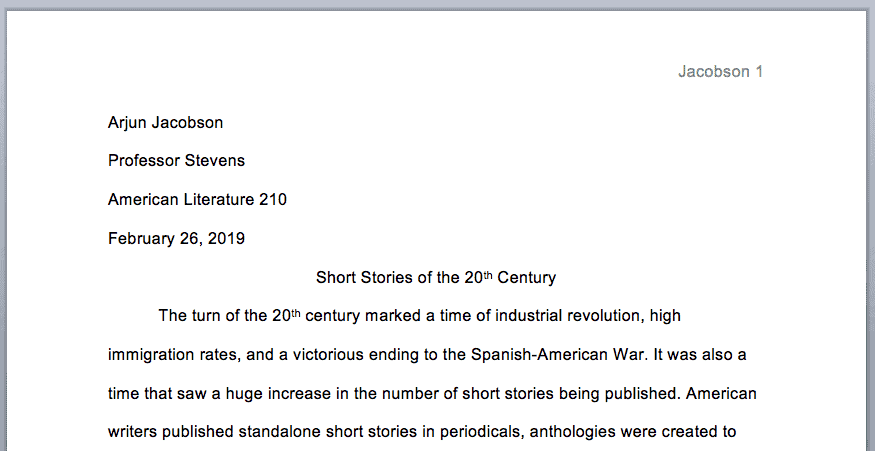
If you need help with sentence structure or grammar, check out our paper checker. The paper checker will help to check every noun, verb, and adjective. If there are words that are misspelled or out of place, the paper checker will suggest edits and provide recommendations.
MLA Works Cited:
- The works-cited list should be on its own page at the end of the paper.s
- If a citation flows onto the second line, indent it in half an inch from the left margin (called a “hanging indent”).
- For more information on the works-cited list, refer to “How to Make a Works Cited Page,” which is found below.
How to Create a Title Page
According to the Modern Language Association’s official guidelines for formatting a research paper, it is unnecessary to create or include an individual title page, or MLA cover page, at the beginning of a research project. Instead, follow the directions above, under “Heading & Title,” to create a proper heading. This heading is featured at the top of the first page of the research paper or research assignment.
If your instructor or professor does in fact require or ask for an MLA title page, follow the directions that you are given. They should provide you with the information needed to create a separate, individual title page. If they do not provide you with instructions, and you are left to create it at your own discretion, use the header information above to help you develop your research paper title page. You may want to include other information, such as the name of your school or university.
How to Make a Works Cited Page
The MLA Works Cited page is generally found at the end of a research paper or project. It contains a list of all the citations of sources used for the research project. Follow these directions to format the works-cited list to match the Modern Language Association’s guidelines.
- The “Works Cited” page has its own page at the end of a research project.
- Include the same running head as the rest of the project (Your last name and then the page number). The “Works Cited” page has the final page number for the project.
- Name the page “Works Cited,” unless your list only includes one citation. In that case, title it in MLA “Work Cited.”
- The title of the page (either “Works Cited” or “Work Cited”) is placed one inch from the top of the page, centered in the middle of the document.
- Double space the entire document, even between the title of the page and the first citation.
- Citations are listed in alphabetical order by the first word in the citation (usually the last name of the author or the first word in the title if the citation does not include the author’s name. Ignore “A,” “An,” and “The” if the title begins with these words.)
- If there are multiple citations by the same author, place them in chronological order by the date published.
- Also, instead of writing the author’s name twice in both citations, use three hyphens.
Example:
%%Angelou, Maya. I Know Why the Caged Bird Sings. Random House, 2009.
%%---. Gather Together in My Name. Random House, 1974.
- All citations begin flush against the left margin. If the citation is long and rolls onto a second or third line, indent the lines below the first line half an inch from the left margin. This is called a “hanging indent.” The purpose of a hanging indent is to make the citations easier to read. If you’re using our MLA citation machine, we’ll format each of your references with a hanging indent for you.
Example:
%%Wai-Chung, Ho. “Political Influences on Curriculum Content and Musical Meaning: Hong Kong Secondary Music Education, 1949-1997.” Journal of Historical Research in Music Education, vol. 22, no. 1, 1 Oct. 2000, pp. 5-25. Periodicals Index Online, search-proquest-com.i.ezproxy.nypl.org/pio/docview/1297849364/citation/6B70D633F50C4EA0PQ/78?accountid=35635.
- MLA “Works Cited” pages can be longer than one page. Use as many pages as necessary. If you have only one source to cite, do not place the one citation below the text of your paper. In MLA, a “Work Cited” page is still created for that individual citation.
Here’s a sample paper to give you an idea of what an MLA paper could look like. Included at the end is an MLA “Works Cited” page example.
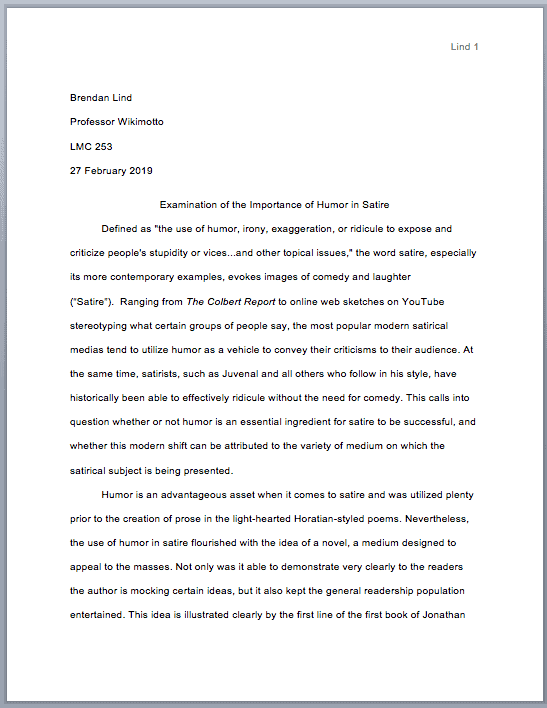
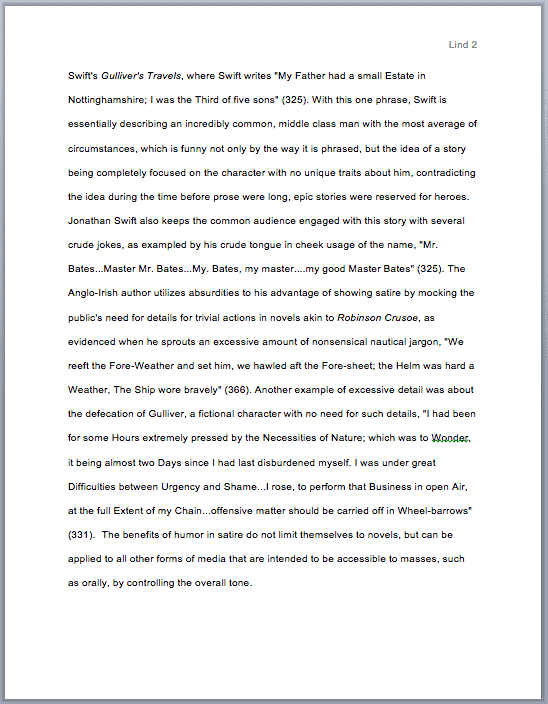
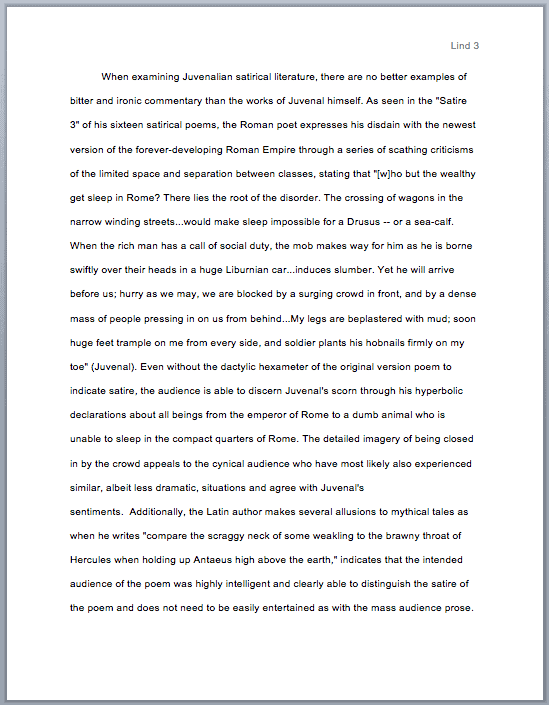
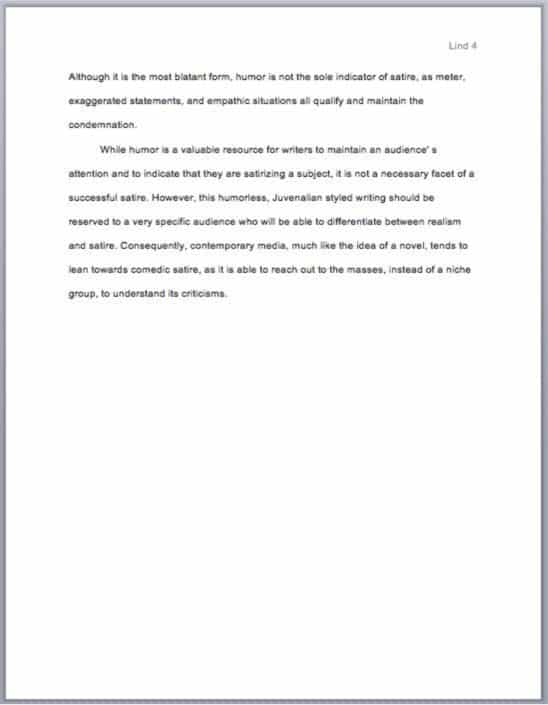
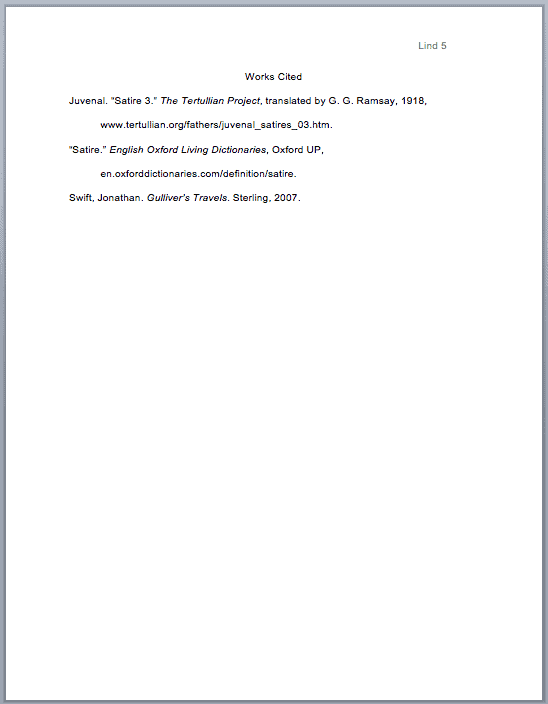 ## Adding Images, Figures, Tables, and Musical Scores
## Adding Images, Figures, Tables, and Musical Scores
Looking to add a relevant image, figure, table, or musical score to your paper? Here’s the easy way to do it, while following guidelines set forth by the Modern Language Association:
- Place the image, figure, table, or music close to where it’s mentioned in the text.
- Provide source information and any additional notes directly below the image, figure, table, or music.
For tables:
- Label the table as “Table” followed by an arabic numeral such as “1.” Table 1 is the table closest to the beginning of the paper. The next table mentioned in the text would be Table 2, and so on.
- Create a title for the table and place it below the label. Capitalize all important words.
- The label (Table 1) and the title should be flush against the left margin.
- Double-space everything.
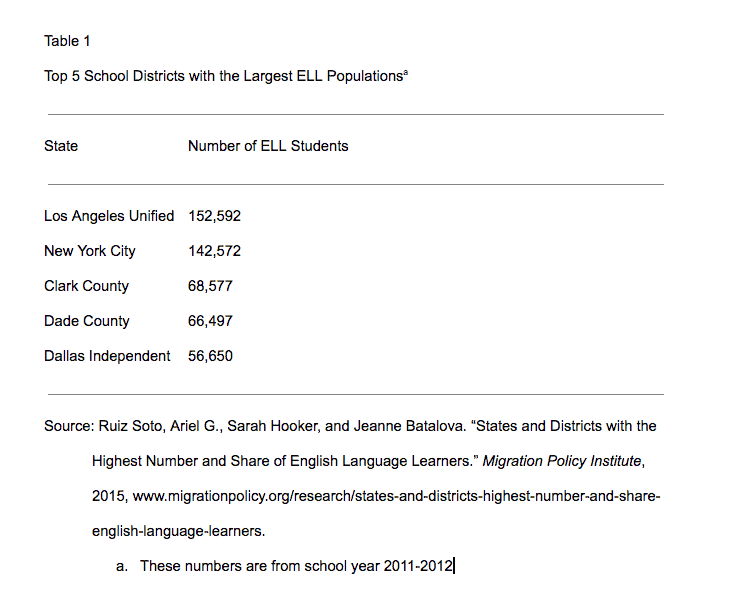
Here is the text description of the MLA table example. ### For figures:
- A figure can be a map, photograph, painting, pie chart, or any other type of image.
- Create a label and place it below the figure. The figure first mentioned in the text of the project is either “Figure 1” or “Fig 1.” Though figures are usually abbreviated to “Fig.” Choose one style and use it consistently. The next mentioned figure is “Figure 2” or “Fig. 2.”, and so on.
- Place a caption next to the label. If all of the source information is included in the caption, there isn’t a need to replicate that information in the works-cited list.
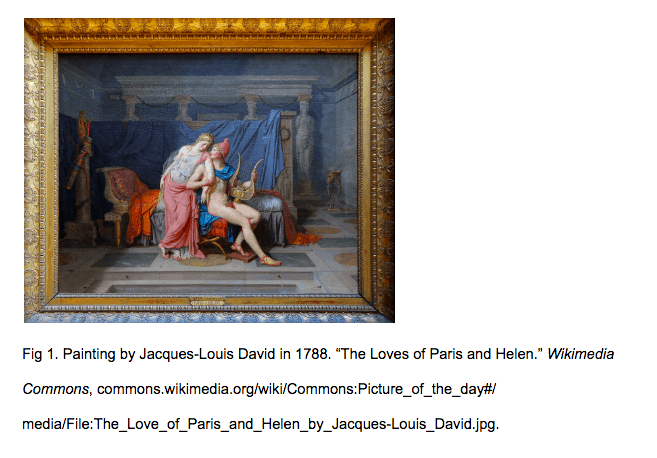
Here is the text description of the MLA figure example.
MLA Final Checklist
Think you’re through? We know this guide covered a LOT of information, so before you hand in that assignment, here’s a checklist to help you determine if you have everything you need:
_ Are both in-text and full citations included in the project? Remember, for every piece of outside information included in the text, there should be a corresponding in-text citation next to it. Include the full citation at the end, on the “Works Cited” page.
_ Are all citations, both in-text and full, properly formatted in MLA style? If you’re unsure, try out our citation generator!
_ Is your paper double-spaced in its entirety with one inch margins?
_ Do you have a running header on each page? (Your last name followed by the page number)
_ Did you use a font that is easy to read?
_ Are all citations on the MLA format works-cited list in alphabetical order?
Our plagiarism checker scans for any accidental instances of plagiarism. It scans for grammar and spelling errors, too. If you have an adverb, preposition, or conjunction that needs a slight adjustment, we may be able to suggest an edit.
Common Ways Students Accidentally Plagiarize
We spoke a bit about plagiarism at the beginning of this guide. Since you’re a responsible researcher, we’re sure you didn’t purposely plagiarize any portions of your paper. Did you know students and scholars sometimes accidentally plagiarize? Unfortunately, it happens more often than you probably realize. Luckily, there are ways to prevent accidental plagiarism and even some online tools to help!
Here are some common ways students accidentally plagiarize in their research papers and assignments:
1. Poor Paraphrasing
In the “How to create a paraphrase” section towards the top of this page, we share that paraphrases are “recycled information, in the paper writer’s own words and writing style.” If you attempt to paraphrase a few lines of text and it ends up looking and sounding too close to the original author’s words, it’s a poor paraphrase and considered plagiarism.
2. Incorrect Citations
If you cite something incorrectly, even if it’s done accidentally, it’s plagiarism. Any incorrect information in a reference, such as the wrong author name or the incorrect title, results in plagiarism.
3. Forgetting to include quotation marks
When you include a quote in your paper, you must place quotation marks around it. Failing to do so results in plagiarism.
If you’re worried about accidental plagiarism, try our Citation Machine Plus essay tool. It scans for grammar, but it also checks for any instances of accidental plagiarism. It’s simple and user-friendly, making it a great choice for stress-free paper editing and publishing.
Updated June 15, 2021
Written and edited by Michele Kirschenbaum and Wendy Ikemoto. Michele Kirschenbaum has been an awesome school librarian since 2006 and is an expert in citing sources. Wendy Ikemoto has a master’s degree in library and information science and has been working for Citation Machine since 2012.